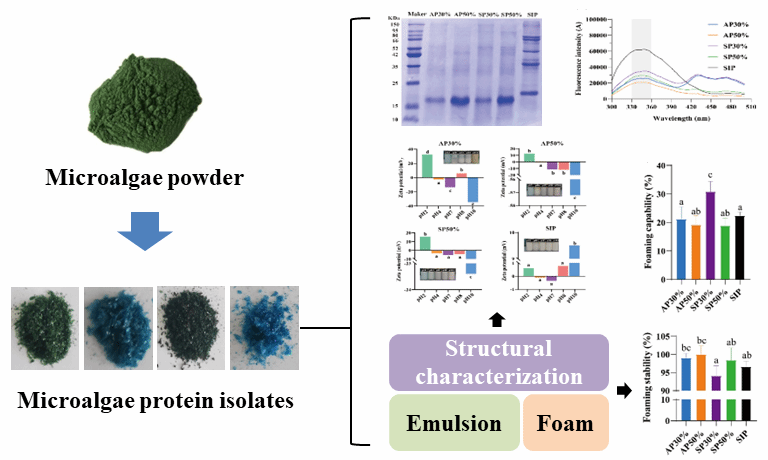Abstract
Microalgae protein holds great potential for various applications in the food industry. However, the current knowledge regarding microalgae protein remains limited, with little information available on its functional properties. Furthermore, the relationship between its molecular structure and functional properties is not well defined, which limits its application in food processing. This study aims to addresses these gaps though an analysis of the emulsibility and foamability of various soluble protein isolates from two species of Spirulina (Arthospira platensis and Spirulina platensis), and the functional properties of Spirulina protein isolates in relation to its molecular structure and charge state. Results revealed that the degree of cross-linking and aggregation or folding and curling of protein tertiary structures was higher in the highly soluble Spirulina protein isolates (AP50% and SP50%) than in the low-solubility isolates (AP30% and SP30%). The foaming capacity (FC) of AP50% and SP50% was found to be lower than that of AP30% and SP30%. Spirulina protein isolates can stably adsorb at the air-water interface for at least 20 min and possessed good interfacial activity. A high pH value was found to promote cross-linking of protein particles at the oil-water interface, thereby reinforcing the internal network structure of emulsions and increasing viscosity. These findings provide preliminary insights for potential applications of Spirulina protein isolates in food production, especially towards quality improvement.
中文摘要:
微藻蛋白在食品工业中具有巨大的应用潜力。然而,目前关于微藻蛋白的研究非常有限,尤其是其功能特性方面的报道很少。此外,微藻蛋白的分子结构与功能特性之间的关系尚不明确,这限制了其在食品加工中的应用。基于上述背景,本研究旨在通过分析两种螺旋藻(Arthospira platensis 和 Spirulina platensis)的可溶性蛋白组分的乳化性和起泡性,揭示螺旋藻蛋白的功能特性与其分子结构和电荷状态的关系。结果表明,高溶解度螺旋藻蛋白组分(AP50%和SP50%)的三级结构交联、聚集或折叠、卷曲程度高于低溶解度组分(AP30%和SP30%)。AP50%和SP50%的起泡能力(FC)低于AP30%和SP30%。螺旋藻蛋白能够在空气-水界面稳定吸附至少20分钟,并具有良好的界面活性。较高的pH值会促进油水界面螺旋藻蛋白的交联,从而增强乳液内部网络结构、提高黏度。这些结果为螺旋藻蛋白在食品加工中的应用奠定了重要理论基础。

论文简介:
随着人口持续增长,传统食物资源将供不应求,亟需开发可持续的食物资源。微藻是一种潜在的新食物资源,一些微藻(如螺旋藻、莱茵衣藻、原壳藻、小球藻、杜氏藻、裸藻)已被FAO批准作为食品/食品成分。微藻具有提升食品品质的作用,例如提高面包的保水性、改善面团的粘弹性、增加烘焙食品的蓬松度。同时,微藻还具有丰富的营养来价值,研究表明其蛋白质含量高于燕麦、鹰嘴豆、大豆、羽扇豆和蚕豆。然而目前关于微藻蛋白的功能特性(包括起泡性和乳化性)研究较少,尤其是微藻蛋白的分子结构与其功能特性之间的关系尚不明确,这限制了微藻蛋白在食品加工中的进一步开发及应用。本研究探究了两种螺旋藻的可溶性蛋白组分的乳化性和起泡性,并深入分析了螺旋藻蛋白的功能特性与其分子结构和电荷状态之间的关系。
研究结果显示,螺旋藻的高溶解度蛋白组分(AP50%和SP50%)三级结构交联、聚集或折叠、卷曲程度高于低溶解度组分(AP30%和SP30%)。与大豆分离蛋白(SIP)相比,螺旋藻蛋白具有更强的氢键相互作用和更紧密/无序的分子结构。螺旋藻蛋白分离物的泡沫稳定性(FS)与SIP相当,均超过90%,并可在空气-水界面稳定吸附至少20分钟,具有良好的界面活性。提高pH值会促进油-水界面螺旋藻蛋白分离物颗粒的交联,增强乳液内部网络结构。螺旋藻蛋白分离物AP30%和SP30%具有作为食品发泡剂和乳化剂的潜力。
该研究成果于2024年4月22日发表于国际学术期刊“Food Research International”。食品学院郭小博士为第一作者,柳鑫教授为通讯作者。该研究得到十四五国家重点研发计划青年科学家项目“微藻蛋白新型食品全链条风险因子高效识别与主动防控关键技术研究(2022YFF1102500)”资助。
文章链接:https://doi.org/10.1016/j.foodres.2024.114407
